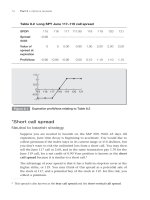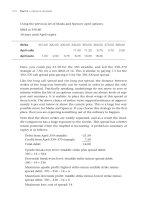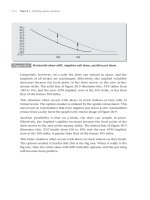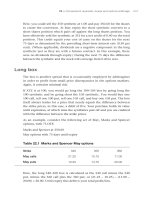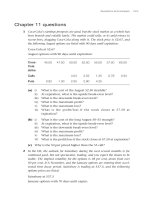CWNA guide to wireless LANs 2nd ch02
Bạn đang xem bản rút gọn của tài liệu. Xem và tải ngay bản đầy đủ của tài liệu tại đây (495.6 KB, 46 trang )
CWNA Guide to Wireless
LANs, Second Edition
Chapter Two
Wireless LAN Devices and Standards
Objectives
• List WLAN devices and describe their basic
functions
• Explain the different types of communication
standards and why standards are important
• List the three major wireless standards and
regulatory agencies and their functions
• Describe the different IEEE WLAN standards
CWNA Guide to Wireless LANs, Second Edit
2
WLAN Devices: Wireless Network
Interface Card
• Network interface card (NIC): Connects computer
to network so that it can send and receive data
• Wireless NICs perform same function, but without
wires
• When wireless NICs transmit:
– Change computer’s internal data from parallel to
serial transmission
– Divide data into packets and attach sending and
receiving computer’s address
– Determine when to send packet
– Transmit packet
CWNA Guide to Wireless LANs, Second Edit
3
WLAN Devices: Wireless Network
Interface Card (continued)
Figure 2-1: Network interface card for a wired network
CWNA Guide to Wireless LANs, Second Edit
4
WLAN Devices: Wireless Network
Interface Card (continued)
Figure 2-2: Wireless NICs for desktop computers: (a) PCI network
interface card, (b) standalone USB device, (c) USB key fob
CWNA Guide to Wireless LANs, Second Edit
5
WLAN Devices: Wireless Network
Interface Card (continued)
Figure 2-3: Wireless NICs for laptop computers: (a) CardBus card;
(b) Mini PCI card
CWNA Guide to Wireless LANs, Second Edit
6
WLAN Devices: Wireless Network
Interface Card (continued)
• For smaller devices, several options:
– CardBus or Type II PC Card
• May require a sled
– CompactFlash (CF) card: Consists of small circuit
board containing flash memory chips and dedicated
controller chip
• Small and consume little power
– SDIO (Secure Digital I/O) or SDIO NOW! Card:
Provides high-speed data input/output with low
power consumption
CWNA Guide to Wireless LANs, Second Edit
7
WLAN Devices: Wireless Network
Interface Card (continued)
• A movement towards integrating wireless NICs
– Would eliminate need for external wireless NICs
• Software drivers necessary to allow wireless NIC
and operating system (OS) to interface
– Windows XP and PDA OSs have built-in drivers
CWNA Guide to Wireless LANs, Second Edit
8
WLAN Devices: Access Point
• Three major parts:
– Antenna and radio transmitter/receiver
– RJ-45 wired network interface
– Special bridging software
• To interface wireless devices to other devices
• Two basic function:
– Base station for wireless network
– Bridge between wireless and wired networks
CWNA Guide to Wireless LANs, Second Edit
9
WLAN Devices: Access Point
(continued)
Figure 2-6: An access point acts as a bridge between the wireless
network and a wired network
CWNA Guide to Wireless LANs, Second Edit
10
WLAN Devices: Access Point
(continued)
• Range depends on several factors:
– Type of wireless network supported
– Walls, doors, and other solid objects
• Number of wireless clients that single AP can
support varies:
– Theoretically over 100 clients
– No more than 50 for light network use
– No more than 20 for heavy network use
• Power over Ethernet (PoE): Power delivered to
AP through unused wires in standard unshielded
twisted pair (UTP) Ethernet cable
CWNA Guide to Wireless LANs, Second Edit
11
WLAN Devices: Remote Wireless
Bridge
• Bridge: Connects two network segments together
– Even if they use different types of physical media
• Remote wireless bridge: Connects two or more
wired or wireless networks together
– Transmit at higher power than WLAN APs
– Use directional antennas to focus transmission in
single direction
– Delay spread: Minimize spread of signal so that it
can reach farther distances
– Have software enabling selection of clearest
transmission channel and avoidance of noise and
interference
CWNA Guide to Wireless LANs, Second Edit
12
WLAN Devices: Remote Wireless
Bridge (continued)
Figure 2-8: Point-to-point remote wireless bridge
CWNA Guide to Wireless LANs, Second Edit
13
WLAN Devices: Remote Wireless
Bridge (continued)
Figure 2-9: Point-to-multipoint remote wireless bridge
CWNA Guide to Wireless LANs, Second Edit
14
WLAN Devices: Remote Wireless
Bridge (continued)
• Four modes:
– Access point mode: Functions as standard AP
– Root mode: Root bridge can only communicate with
other bridges not in root mode
– Non-root mode: Can only transmit to another bridge
in root mode
– Repeater mode: Extend distance between LAN
segments
• Placed between two other bridges
• Distance between buildings using remote wireless
bridges can be up to 18 miles at 11 Mbps or 25
miles transmitting 2 Mbps
CWNA Guide to Wireless LANs, Second Edit
15
WLAN Devices: Remote Wireless
Bridge (continued)
Figure 2-10: Root and non-root modes
CWNA Guide to Wireless LANs, Second Edit
16
WLAN Devices: Remote Wireless
Bridge (continued)
Figure 2-11: Repeater mode
CWNA Guide to Wireless LANs, Second Edit
17
WLAN Devices: Wireless Gateway
• Combines wireless management and security in
single appliance
–
–
–
–
–
Authentication
Encryption
Intrusion detection and malicious program protection
Bandwidth management
Centralized network management
CWNA Guide to Wireless LANs, Second Edit
18
Understanding Standards
• Standards make it easier to purchase and use wide
variety of products
• Wireless technology based on standards
– Standards help ensure different products from
different vendors function in same capacity
CWNA Guide to Wireless LANs, Second Edit
19
The Need for Standards
• Standards for telecommunications have been
essential since very beginning
– Without standards telecommunications would
essentially be impossible
• Some IT professionals believe that standards have
stifled growth in the field
– Waiting for standards to catch up to changes slows
down process of change and development
• In reality, standards have proven to be more
beneficial than harmful
CWNA Guide to Wireless LANs, Second Edit
20
Advantages and Disadvantages of
Standards
Table 2-1: Advantages and disadvantages of standards
CWNA Guide to Wireless LANs, Second Edit
21
Types of Standards
• De facto standards: Common practices that the
industry follows for various reasons
– Ranging from ease of use to tradition to what
majority of users do
– Usually established by success in marketplace
• De jure standards: Official standards
– Controlled by organization or body that has been
entrusted with that task
– Process for creating these standards can be very
involved
CWNA Guide to Wireless LANs, Second Edit
22
Types of Standards (continued)
• One complaint against de jure standards is amount
of time it takes for a standard to be completed
• Consortia: Usually industry-sponsored
organizations that want to promote a specific
technology
– Goal is to develop a standard that promotes
organization’s specific technology in little time
CWNA Guide to Wireless LANs, Second Edit
23
Enforcing Standards
• Marketplace itself enforces some standards
– Standards created by consortia often regulated by
marketplace
• De jure standards often enforced by outside
regulatory agency
– Ensure that participants adhere to prescribed
standards
– Must have power to enforce standards and
effectively punish those who refuse to abide by them
CWNA Guide to Wireless LANs, Second Edit
24
Wireless Standards Organizations and
Regulatory Agencies
• Three primary standard-setting and regulatory
bodies that play major role in wireless LAN
technology
– Institute of Electrical and Electronics Engineers
(IEEE)
– Wi-Fi Alliance
– U.S. Federal Communications Commission (FCC)
CWNA Guide to Wireless LANs, Second Edit
25




